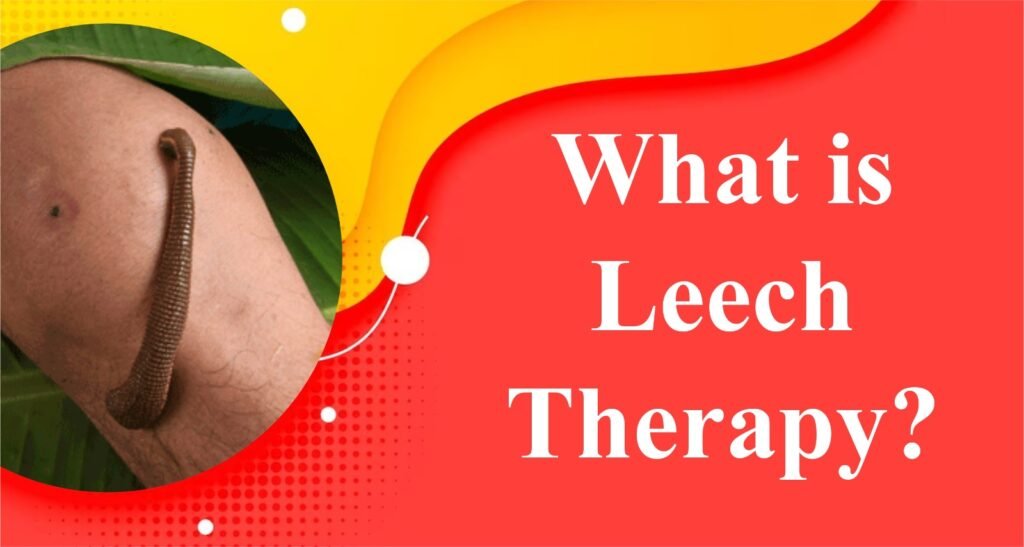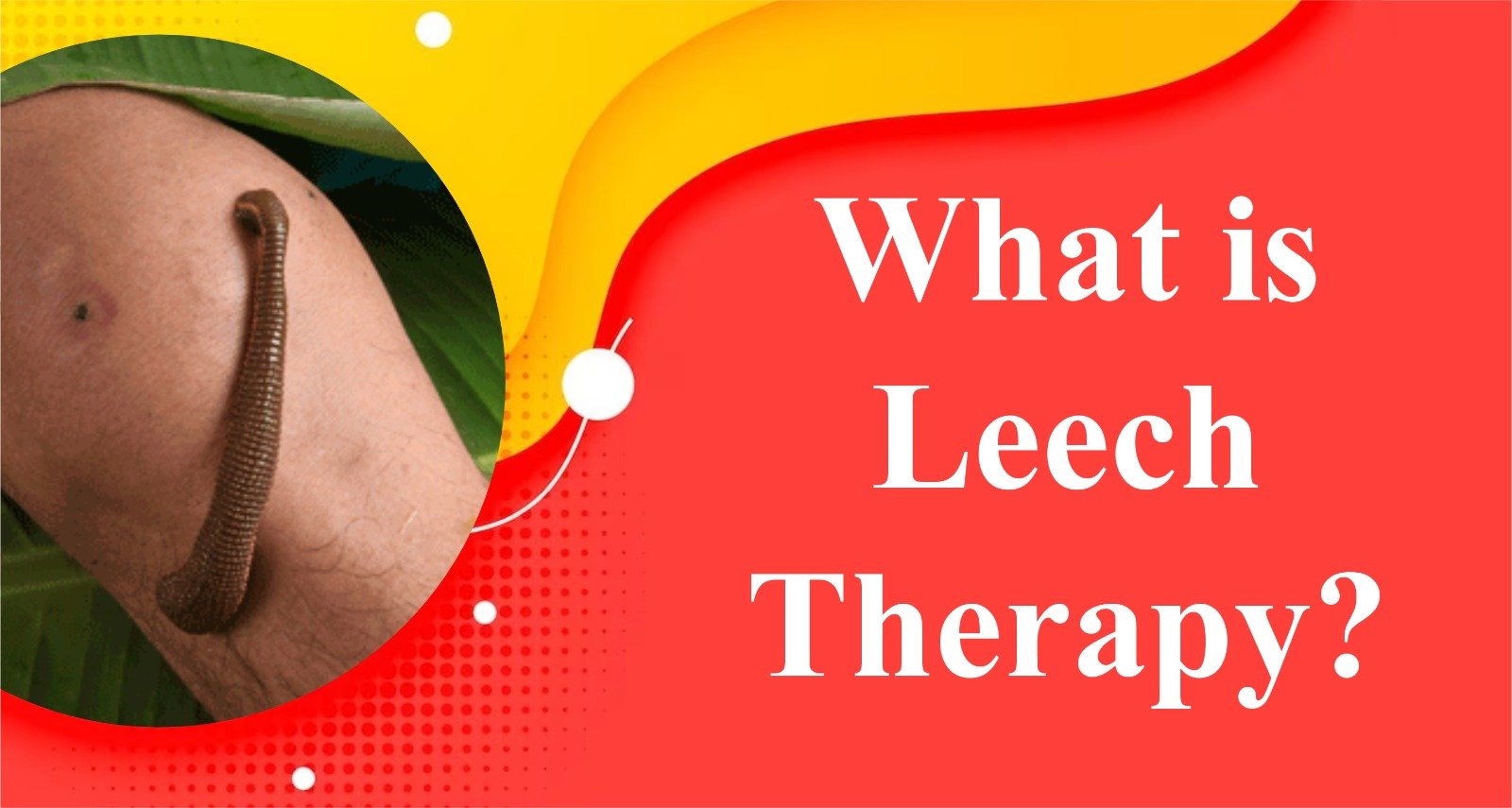Leech therapy, also known as “Jalaukaavacharana” in Ayurveda, is an ancient therapeutic practice that involves the use of medicinal leeches for various health benefits. This practice has been a part of traditional medicine systems, including Ayurveda, for centuries.
The practice of leech therapy, known as “Jalaukaavacharana” in Ayurveda, has a historical foundation, with the Sushruta Samhita, an ancient Ayurvedic text, dedicating an entire chapter to hirudino therapy. However, the early 20th century marked a significant setback for this therapy, attributed to the advent and widespread use of antibiotics.

Today we are going to share details about the Ayurvedic Leech therapy procedure definition and its benefits.
Definition of Leech Therapy?
According to Ayurveda, this therapy is believed to balance the doshas (Vata, Pitta, and Kapha), improve blood circulation, and remove impurities from the blood.
The leeches used in Ayurvedic leech therapy are specially bred and raised under controlled conditions. When applied to the skin, leeches release bioactive substances in their saliva, including enzymes, anticoagulants, and anti-inflammatory compounds. These substances are thought to have therapeutic effects, such as improving blood flow, reducing inflammation, and detoxifying the blood.
Leech therapy in Ayurveda is often recommended for various health conditions, including skin disorders, joint problems, circulatory issues, and certain inflammatory conditions. It is essential to undergo this therapy under the guidance of a qualified Ayurvedic practitioner who can determine the appropriate use of leeches and monitor the treatment process to ensure its safety and efficacy.
Process of Leech Therapy
The process of leech therapy, or Jalaukaavacharana, in Ayurveda involves several steps. Here’s a general overview of the procedure:
- Patient Evaluation: Before recommending leech therapy, an Ayurvedic practitioner assesses the patient’s overall health, medical history, and specific health concerns. This evaluation helps determine whether leech therapy is a suitable treatment option.
- Selection of Medicinal Leeches: Medicinal leeches used in Ayurvedic therapy are typically bred and raised under controlled conditions. These leeches are carefully selected for their medicinal properties. They are free from diseases and are specifically chosen based on the therapeutic goals of the treatment.
- Preparation of the Patient: The area of the body where leeches will be applied is prepared by cleaning and disinfecting the skin. This is done to minimize the risk of infection.
- Application of Leeches: The selected leeches are then placed on the predetermined areas of the patient’s body. The leeches are allowed to attach themselves to the skin and initiate the process of bloodsucking.
- Leech Feeding and Detachment: As the leeches feed, they release saliva containing various bioactive substances, such as enzymes and anticoagulants. This saliva is believed to have therapeutic effects. Once the leeches have ingested a sufficient amount of blood or are naturally detached, they are carefully removed from the patient’s skin.
- Post-Treatment Care: After the leech therapy session, the treated area is cleansed, and the patient is provided with appropriate post-treatment care instructions. This may include dressing the wounds, applying medicinal pastes or oils, and following dietary recommendations.
- Follow-up and Monitoring: The patient’s progress is monitored over subsequent days and weeks. Follow-up consultations with the Ayurvedic practitioner help assess the effectiveness of the leech therapy and make any necessary adjustments to the treatment plan.
It’s important to note that leech therapy should be administered by qualified Ayurvedic practitioners who have expertise in this traditional healing method. Additionally, the therapy’s application and efficacy may vary based on the individual’s health condition and the specific goals of treatment.
Benefits of Leech Therapy
Leech therapy in Ayurveda is believed to offer various potential benefits, although it’s important to note that scientific evidence supporting all these claims may be limited. Some reported benefits include:
- Blood Circulation Improvement: Leech therapy is thought to enhance blood circulation by removing stagnant blood and promoting the flow of fresh, oxygenated blood to the treated area. This is believed to contribute to overall cardiovascular health.
- Detoxification: Leeches release bioactive substances in their saliva, which are believed to have detoxifying effects. This process may help remove impurities and toxins from the blood, supporting the body’s natural detoxification mechanisms.
- Anti-Inflammatory Effects: The enzymes and compounds present in leech saliva are considered to have anti-inflammatory properties. This can be beneficial for conditions characterized by inflammation, such as arthritis or inflammatory skin disorders.
- Pain Relief: Leech therapy is sometimes used to alleviate pain, particularly in conditions involving joint pain, musculoskeletal disorders, or localized pain. The anti-inflammatory and blood-thinning properties of leech saliva may contribute to pain relief.
- Wound Healing: The enzymes in leech saliva are believed to have a positive impact on wound healing. Leech therapy is sometimes applied to wounds to promote healing and reduce the risk of infection.
- Skin Disorders: Ayurvedic practitioners may recommend leech therapy for certain skin conditions, such as psoriasis or eczema. The therapy is thought to improve skin health by enhancing blood circulation and reducing inflammation.
- Varicose Veins and Circulatory Disorders: Leech therapy is sometimes suggested for conditions involving poor blood circulation, such as varicose veins. The improved blood flow is believed to have a positive effect on circulatory disorders.
- Therapeutic for Specific Conditions: Ayurvedic practitioners may recommend leech therapy as part of a comprehensive treatment plan for specific health conditions, including certain liver disorders, migraine headaches, and gynecological issues.
Precautions during Leech Therapy
While leech therapy has been used traditionally in Ayurveda for various health conditions, it’s important to take certain precautions to ensure the safety and effectiveness of the treatment. Here are some precautions to consider during leech therapy:
Qualified Practitioner: Ensure that the leech therapy is administered by a qualified and experienced Ayurvedic practitioner. They should have the necessary knowledge and expertise to assess your health condition, determine the appropriateness of leech therapy, and carry out the procedure safely.
Hygiene and Sterilization: The treatment area and all instruments used during leech therapy should be clean and sterile to minimize the risk of infection. Both the practitioner and the patient should follow proper hygiene practices before and after the procedure.
Screening for Contraindications: Leech therapy may not be suitable for everyone. It’s important to screen for contraindications, such as bleeding disorders, anemia, compromised immune system, or specific medical conditions that may pose risks during the therapy.
Individualized Treatment Plan: The treatment plan should be tailored to the individual’s health condition and requirements. Not every person may benefit from leech therapy, and the number of leeches used and the frequency of sessions should be determined based on the specific health goals.
Monitoring During the Procedure: A qualified practitioner should closely monitor the patient during the leech therapy session. This includes observing the attachment and feeding process of the leeches, as well as addressing any discomfort or adverse reactions promptly.
Post-Treatment Care: Following the therapy, the treated area should be properly cleaned and cared for to minimize the risk of infection. The practitioner may recommend specific post-treatment measures, such as applying medicinal pastes or oils to aid in the healing process.
Allergic Reactions: Some individuals may be sensitive or allergic to components in leech saliva. If there is any sign of an allergic reaction, such as itching, swelling, or difficulty breathing, it’s crucial to seek medical attention immediately.
Pregnancy and Nursing: Leech therapy is generally not recommended during pregnancy and lactation. Pregnant or nursing women should consult with their healthcare provider before considering leech therapy.
Communication with Healthcare Providers: It’s important to inform your primary healthcare provider about any alternative or traditional treatments you are undergoing, including leech therapy. This ensures coordinated and comprehensive healthcare.
Informed Consent: Before undergoing leech therapy, obtain a thorough understanding of the procedure, its potential benefits, and any associated risks. Provide informed consent before the treatment.


One thought on “Leech Therapy (Jaloka Therapy) in Ayurveda – Benefits, Procedure and Precautions”